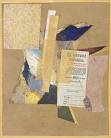Kurt Schwitters and the avant-garde
dal 2/3/2007 al 27/5/2007
Segnalato da
2/3/2007
Kurt Schwitters and the avant-garde
Museum Boijmans Van Beuningen, Rotterdam
The retrospective presents an overview of Schwitters' oeuvre and consists of more than 300 paintings, assemblages, collages, reliefs, sculptures and documents. In addition, the exhibition also provides the opportunity to view his work within the context of modernism. By zooming in, at crucial moments, on the artistic discussions he had with befriended colleagues, it also shows a kaleidoscopic picture of the international avant-garde at the start of the twentieth century.

Retrospective
Museum Boijmans Van Beuningen organizes a large retrospective devoted to the work of Kurt Schwitters. It is the first time that the work of this German avant-garde artist can be seen on this scale in the Netherlands. In addition to paintings, collages and assemblage, Schwitters' 'Gesamtkunstwerk', the Merzbau, can also be seen. The exhibition presents an overview of Schwitters' oeuvre and consists of more than 300 paintings, assemblages, collages, reliefs, sculptures and documents. In addition, the exhibition also provides the opportunity to view his work within the context of modernism. By zooming in, at crucial moments, on the artistic discussions he had with befriended colleagues, it also shows a kaleidoscopic picture of the international avant-garde at the start of the twentieth century. The exhibition includes loans from, among others, the MOMA in New York and the Centre Pompidou in Paris, and a considered selection from the rich collection of the Sprengel Museum in Hannover.
Impressive network
Kurt Schwitters was a networker. He maintained contacts with an impressive array of prominent artists, poets and collectors. From Hans Arp to Piet Zwart. If you look at Schwitters' address book, you can find the entire international avant-garde right away: Hannah Hoch and Raoul Haussmann in Berlin, Theo van Doesburg in Leiden, Weimar and Paris, El Lissitzky, Moholy-Nagy, Piet Mondriaan; the Rinsema brothers in Drachten and later on Ben Nicholson and Barbara Hepworth in London. There were all sorts of practical and personal 'issues' between Schwitters and his friends, but especially discussions about art as well. About who, what, where and why, and about where to go next with the visual art traditions in a modern age. And about which part art should play in a wounded, but hopeful and changing society.
The exhibition examines this dialogue. For instance, Schwitters' contribution to the scandalous Dutch dada tour of 1923. And the Ring Neue Werbegestalter, founded by him, in which from 1925 onwards an elite of artists/typographers developed avant-garde printed matter, with advertising and commercialism as its goal.
A special feature of the exhibition is the inclusion of Schwitters' Merzbau. Schwitters regarded this 'Gesamtkunstwerk' as his life's work.
Merz is Schwitters
Kurt Schwitters (1887-1948) is one of the most important representatives of the international avant-garde. During the First World War he comes into contact with the work of cubist and expressionist artists of the Berlin gallery Der Sturm (Franz Marc and George Braque among them). In 1918 he meets dadaists Hans Arp, Raoul Haussmann and Hannah Hoch, with whom he becomes friends for life. Schwitters creates images with material from everyday life, such as tram tickets, rope, crooked wheels. He calls his art Merz, the second syllable of the word Commerz. The name leads to the well-known Merzbild, a work in which the word 'merz' can be read in between abstract shapes, pasted cut-outs from an advertisement by the Kommerz- und Privatbank.
Merz is of great importance to the development of modern art, as explained by the Merz artist:
'Merz is consistent. Merz cultivates nonsense. Merz builds the new from fragments. Merz develops the studies for a communal creation of the world. Merz detoxifies. Merz is Kurt Schwitters.' Working from this Merz concept Schwitters writes manifestoes and poems, and also creates assemblages and reliefs. During the 1920's his style changes, under the influence of his close ties with the artists of the De Stijl movement, especially with Theo van Doesburg, but also those with constructivists like László Moholy-Nagy and El Lissitzky. Schwitters is co-founder of the Ring Neue Werbegestalter, a group of typographers that includes Jan Tschichold and Willi Baumeister. Around 1930 he joins two international groups of artists in Paris, Cercle et Carré and Abstraction-Création, who feel very strongly about abstraction as an internationally understandable visual idiom. From 1931 onwards, thanks to an inheritance from his father, Schwitters can devote himself completely to art. In 1937 he flees advancing National-Socialism by moving to Norway, and in 1940 to England. This is a difficult but also productive period for Schwitters. Without renouncing his individualism, he joins in with the black humor of English surrealism. On January 8, 1948, he dies in Ambleside, a village in the Lake District.
Opening: 3 march 2007
Museum Boijmans Van Beuningen
Museumpark 18-20 - Rotterdam



